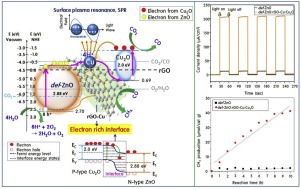Applied Catalysis B: Environment and Energy ( IF 20.2 ) Pub Date : 2020-01-16 , DOI: 10.1016/j.apcatb.2020.118648 Jun Neoung Heo , Junyeong Kim , Jeong Yeon Do , No-Kuk Park , Misook Kang

|
As an ecological mimicry system, carbon dioxide (CO2)-to-fuel conversion in artificial photosynthesis is quite attractive as a method to simultaneously solve the global energy crisis and environmental problems. Although many researchers have spent a lot of time on efficient charge separation and on enhanced light harvesting, photocatalysts still exhibit poor activity. Nevertheless, designing new types of photocatalysts is still worth attempting. Herein, a localized surface plasmon resonance enhanced the self-assembled rGO-Cu electron-rich interface in a defected ZnO:rGO-Cu:Cu2O composite resulted to inhibit the relaxation of excited electrons by continuously supplying electrons into the vacant holes of Cu2O. The defected ZnO exhibited a diminished band-gap and a higher adsorption of CO2. Under visible irradiation, methane (CH4) produced from CO2 accumulated to 41.0 μ mol g-1 over 10 h on def-ZnO:rGO-Cu:Cu2O, which corresponded to at least 10 times the CH4 amounts compared with the reported ZnO-based catalysts. Ultimately, this work provided new approaches for designing photocatalysts to improve CO2 conversion in gas-phase reaction systems as self-assembling the electron-rich interface and inducing the lattice oxygen defect.
中文翻译:

缺陷ZnO:rGO-Cu:Cu 2 O中自组装的富电子界面和有效的可见光诱导的二氧化碳光还原
作为一种生态模仿系统,人造光合作用中的二氧化碳(CO 2)转化为燃料的方法作为同时解决全球能源危机和环境问题的一种方法非常有吸引力。尽管许多研究人员花了很多时间进行有效的电荷分离和增强光的收集,但是光催化剂的活性仍然很差。尽管如此,设计新型的光催化剂仍然值得尝试。在此,局部表面等离子体共振增强了缺陷的ZnO:rGO-Cu:Cu 2 O复合材料中rGO-Cu自组装的富电子界面,从而通过向Cu的空洞中连续提供电子来抑制激发电子的弛豫。2O.缺陷的ZnO的带隙减小并且对CO 2的吸附更高。在可见光照射下,在def- ZnO:rGO-Cu:Cu 2 O上,CO 2产生的甲烷(CH 4)在10小时内累积到41.0μmol g -1,相当于CH 4量的至少10倍。报道的基于ZnO的催化剂。最终,这项工作为自组装富电子界面并诱发晶格氧缺陷提供了新的方法来设计光催化剂,以提高气相反应系统中的CO 2转化率。











































 京公网安备 11010802027423号
京公网安备 11010802027423号